S Spain in spring: Strait of Gibraltar, Doñana & Extremadura (2)
John Muddeman
07/05/2009 10:59:10
Details from the second half of this Travelling Naturalist tour
Posted in: Flora, Dragonflies and Damselflies, Birds | Andalusia, Extremadura | Southern Spain, Western Spain
Saturday 25th April
A pre-breakfast walk at the Finca was less lively than hoped, especially given very chilly conditions until the sun rose and gave us some relative warmth. However, singing Common Nightingale and Eurasian Hoopoe kicked off the list, and a small selection of the local birds were appreciated, including our first Woodlark in song-flight. A fly-over male Golden Oriole was at least seen, unlike two pairs of extremely fast Hawfinches speeding past.
Leaving at 9:30 we headed out towards Santa Marta de Magasca, 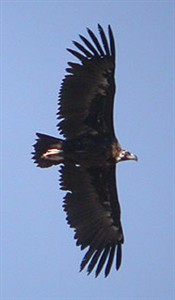 Eurasian Black Vulture
Eurasian Black Vulture
Aegypius monachus© John Muddeman where a chilly keen breeze stopped the temperature from rising much, though we were quickly looking at calling male Little Bustards and a fine Southern Grey Shrike, which helped forget it for a while. Taking a side track we looked over a different part of the same field, and after considerable straining of the eyes, were finally able to make out the forms and colours of two delightful Pin-tailed Sandgrouse, feeding distantly on the slopes. Unfortunately, we only noticed a young Spanish Imperial Eagle which passed very low directly overhead, once it was already past us, and it quickly dropped out of sight. A couple of standing Great Bustards were quite good recompense however!
Another nearby set of fields produced a few Greater Short-toed Larks (including two superbly from the minibus), plus a few fly-over raptors including Black Vulture and Common Buzzard (which had been all but absent until now!), and en route to a drinks break, a few circling birds caused us to stop quickly, and we jumped out to first one, then two and finally three adult Black Storks wheeling over in display flight before they suddenly turned and glided off into the distance. A Woodlark carrying food in its beak perched well for all to admire on the other side of the road.
Refreshments and comfort stop over the Río Magasca seemed like a great place to stop for lunch. Given the wind, most raptors passed very high, but Griffon and Black Vultures, and also an adult Golden Eagle were all finally seen well in the scopes. The European Bee-eaters, Red-rumped Swallows and Eurasian Crag Martins around the bridge were just as well appreciated too, while several Spanish Terrapins and a large Viperine Snake in the river were also admired. Well, by most!
The remainder of the time was spent slowly driving the pseudosteppe in a loop towards Trujillo. Lesser Kestrels, Montagu’s Harriers, both large vultures, both large kites, a few Short-toed Eagles and dozens of Calandra Larks were of most note apart from a single Turtle Dove, which looped around before landing close to the road and gave great views both perched and when feeding on the ground, though this and two Northern Wheatears here, plus an earlier female Whinchat were the only obvious migrants the whole day.
An hour exploring the centre of old Trujillo was followed with a few minutes at a pool on the outskirts of town, where a couple of pairs of Black-winged Stilts, c. 10 Little Ringed Plovers and smaller numbers of both White Wagtails and Little Grebes, plus a lone Common Sandpiper, gave excellent views.
The cloud rolled in and stiff breeze kept blowing, leaving us wondering about the following morning...
Sunday 26th April
The driver plus three headed off shortly after 7:30 in the quest of Little Owls and Great Spotted Cuckoos. Not far from the Finca Irene spotted our first Little Owl on the roadside, which fortunately stayed put, even when we reversed to get great looks. Our second was out on a dry stone wall, though quickly disappeared when we tried to get out with the scopes.
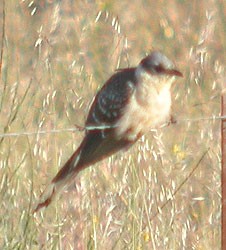 Great Spotted Cuckoo
Great Spotted Cuckoo
Clamator glandarius© John Muddeman It was very cold out, so long-distance views of a bird on a wire fence were not so great, since the ground was producing a little heat haze, but our first Great Spotted Cuckoo was at least clocked, and backed-up when we also heard it, or its nearby mate, calling loudly. Close European Stonechats, Corn Buntings and Southern Grey and Woodchat Shrikes were also admired, as were the first of several Thekla Larks in scrubby areas, though two more Little Owls decided to fly off just as the scopes were trained on them! A fine pair of close Great Spotted Cuckoos were then found, with one of these subsequently watched quite close on the ground. The early morning sun picked out European Bee-eaters colours to perfection and we finished off first with an Iberian Hare, then another very close but brief Great Spotted Cuckoo, and finally a pair of Red-legged Partridge.
Our first stop after breakfast was at the Río Almonte. The river flanked by a band of white water crowfoot flowers was gorgeous, and with a number of Grey and White Wagtails, plus two Common Sandpipers and a good number of Spanish Terrapins was rewarding to look at closely. The raptors overhead were varied too, with Black and Griffon Vultures, Booted and Short-toed Eagles and Black Kites allowing us to practise our increasing ID skills.
A scrubby area near Jaraicejo was our next stop, and this was superb, with fine singing male Dartford and Spectacled Warblers, Thekla and a fly-by Calandra Lark, plus circling Black Stork, Black Vultures and displaying Booted Eagles. A walk produced a few more goodies in a Cork Oak grove, including Crested Tit, Eurasian Nuthatch and a calling Lesser Spotted Woodpecker, plus singing Western Orphean Warbler on our return.
After a reviving coffee stop en route (just after a pair of Common Cuckoos, the female of which was a hepatic morph bird perched on a wire), we took lunch in a little side valley near Almaraz. This was terrific, and though a flighty Eurasian Jay and extremely high pair of displaying Bonelli’s Eagles eluded most, the singing Golden Orioles, feeding Rock Bunting and passing Egyptian Vulture did not. With a fine Hawfinch perched fully in the open and just in front of all of us for several minutes, we were experiencing a purple patch!
Higher up and with looks down towards a reservoir were also rewarding, with a distant Black Wheatear, male Blue Rock Thrush and, just as we were about to leave, calling Red-billed Choughs! These were then watched inspecting a deep rock crevice, finally only reappearing ‘properly’ of course, once we were leaving in the vehicle!
Our final stop was at the Arrocampo reservoir, though in several parts. The first showed that it was relatively quiet, despite several quartering Gull-billed Terns, two flight views of Little Bittern, a brief Kingfisher in flight and 4 or 5 short, but clear views of a perched singing Savi’s Warbler close in front. Another objective achieved! If only the Cetti’s were so cooperative!
Picking up a key at a local bar we also made two brief visits to hides 1 and 2, but with a moderate wind, strong sun and it now simply being late afternoon, it was no surprise that we saw relatively little, despite a brief Purple Swamphen (Brian) and several Purple Herons of most note.
We returned rapidly with plenty of time for ‘coffee, cakes and call-over’ before readjourning at 20:15 to head up to Trujillo for dinner in a restaurant in the old square.
Monday 27th April
The forecast was uncertain but we awoke to crystal clear skies 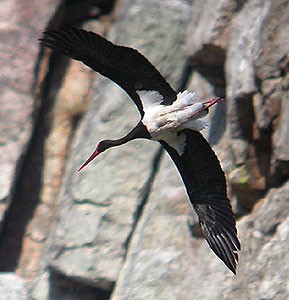 Black Stork Ciconia nigra© John Muddemanagain, despite a chilly breeze. The route to Monfragüe was punctuated by one stop for a look over the dehesa, and after checking a fine Eurasian Jay which appeared to catch an unfortunately baby bird, there was a fine perched Spanish Imperial Eagle, basking in the morning sun. Being a ‘checkerboard’ immature, it was even better to see when it flew down and across into a Holm Oak treetop, sending a number of Iberian Magpies into a frenzy, before appearing with a small prey which it carried off to eat out of sight. Presumably a hapless baby magpie!
Black Stork Ciconia nigra© John Muddemanagain, despite a chilly breeze. The route to Monfragüe was punctuated by one stop for a look over the dehesa, and after checking a fine Eurasian Jay which appeared to catch an unfortunately baby bird, there was a fine perched Spanish Imperial Eagle, basking in the morning sun. Being a ‘checkerboard’ immature, it was even better to see when it flew down and across into a Holm Oak treetop, sending a number of Iberian Magpies into a frenzy, before appearing with a small prey which it carried off to eat out of sight. Presumably a hapless baby magpie!
Our first stop in the park was among many other observers at the Salto del Gitano, looking across to Peñafalcón. Almost immediately a male Peregrine, then a pair of adult Bonelli’s Eagles with a pair of Egyptian Vultures circled high over, but when one of the adult eagles decided to cruise into the park it was vigorously attacked by the Peregrine! After also enjoying our first circling Black Storks here we then saw a young adult Spanish imperial Eagle go over, also mercilessly attacked by the Peregrine, until this was finally left in peace to circle up alongside a Black Stork. Wow!
Just the Griffons plus a few Black Vultures would have been impressive enough in themselves, but a very distant Black Wheatear, numerous Eurasian Crag Martins plus a few Red-rumped Swallows, a singing Rock Bunting and a couple of gorgeous Blue Rock Thrushes were a terrific supporting cast! A singing Black Redstart though dropped off its unseen cliff perch and out of sight forever... A showy Black Stork spiralled down and went to see its mate on the nest, giving terrific views.
Looking over the Puente del Cardenal (largely uncovered given such low water levels) it seemed very quiet in comparison, despite several Alpine Swifts among hundreds of Common House Martins, Griffons on their nests and a lovely Subalpine Warbler out in full view... So we headed for a well-earned drinks break in Villareal de San Carlos!
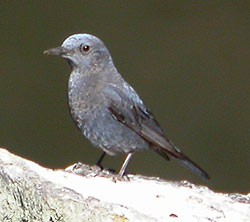 Blue Rock Thrush Monticola solitarius© John Muddeman Stops at various vantage points afterwards produced a few Thekla Larks, Woodchat Shrikes and Corn Buntings, but no wheatears, though a couple of Red-rumped Swallows glowed in the sun, a Woodlark sang its heart out and even a singing Spectacled Warbler showed briefly for Brian and John. A stop in the pinewood only produced a very brief Crested Tit and a couple of Red Deer, so it was on to the Portilla del Tiétar for lunch.
Blue Rock Thrush Monticola solitarius© John Muddeman Stops at various vantage points afterwards produced a few Thekla Larks, Woodchat Shrikes and Corn Buntings, but no wheatears, though a couple of Red-rumped Swallows glowed in the sun, a Woodlark sang its heart out and even a singing Spectacled Warbler showed briefly for Brian and John. A stop in the pinewood only produced a very brief Crested Tit and a couple of Red Deer, so it was on to the Portilla del Tiétar for lunch.
This was about as good as could be expected (!), but with three sightings of an adult Spanish Imperial Eagle, two pairs of noisy circling and perched Black Storks, Griffon and passing Black Vultures, things were definitely good! Noisy passing Long-tailed Tits, singing Cetti’s Warbler, European Robin and Rock Bunting also kept the small bird theme alive, but the undoubted stars were a pair of still fluffy Eurasian Eagle Owl chicks with their huge orange eyes, peering out from under a bush, until one finally took a short walk in the open!
With a couple of gaps in the list still, we took a short drive to a nearby grazing area, which held a number of ‘badger-headed’ Rock Sparrows plus a single Mistle Thrush, but new birds for the group. We returned in our quest for Great Spotted Woodpecker (to no avail) and Black Redstart... No luck with the latter at Peñafalcón again, but it was still lovely to be there, and with Common Ravens and three Short-toed Eagles together at one point, as well as numerous vultures, it was certainly impressive and a great end to the day!
Tuesday 28th April
We left the heavily overcast, cool and breezy Finca at just after 7 a.m. However, dropping down to the S it brightened a little, and certainly enough for us to see a huge Eurasian Eagle Owl lift off its pylon perch and fly across in front of us before disappearing up a bushy slope!
A short stop to refuel and we were off across open steppe, 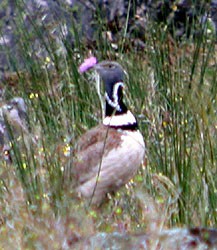 male Little Bustard Tetrax tetrax© John Muddemanmostly slowly, looking for suitable terrain as we went. However, as in the Santa Marta de Magasca area, there were unusually virtually no either bare or almost bare fallow fields, so we continued down to a side road. Stepping out flushed two Great bustards at close range, with 8 more in the same two fields in front! Several male Little Bustards were also strutting their stuff, running around with fluffed-up necks and cavorting around in front of two tail-cocking females. A superb sight! A few even did their exaggerated display flights, wingtips whistling as they flew with wings down and head up, showing off their white pattern to full effect. Further scanning produced a fine pair of Stone-curlews too, in addition to the numerous singing Calandra Larks. This really was special!
male Little Bustard Tetrax tetrax© John Muddemanmostly slowly, looking for suitable terrain as we went. However, as in the Santa Marta de Magasca area, there were unusually virtually no either bare or almost bare fallow fields, so we continued down to a side road. Stepping out flushed two Great bustards at close range, with 8 more in the same two fields in front! Several male Little Bustards were also strutting their stuff, running around with fluffed-up necks and cavorting around in front of two tail-cocking females. A superb sight! A few even did their exaggerated display flights, wingtips whistling as they flew with wings down and head up, showing off their white pattern to full effect. Further scanning produced a fine pair of Stone-curlews too, in addition to the numerous singing Calandra Larks. This really was special!
We finally moved on after scanning the surrounding grassland, and started to search for fallow fields, though without success. However, taking a wide track towards a finca, 13 huge male Great Bustards stood proud on the skyline and a diminutive-looking Greater short-toed Lark fed quietly on some bare soil. But best was when a call from Brian alerted us a small bird whirring along in front. A Common Quail! This then pitched into a short-grass field, and then stood still in full view as we looked in amazement. It even stayed despite a farm worker coming, getting out of his vehicle and then politely saying that despite being on private property would could have a little look around before heading off! 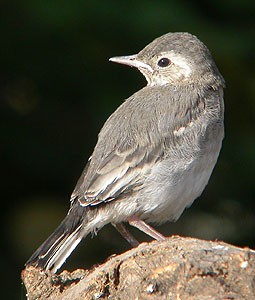 A just-fledged White Wagtail
A just-fledged White Wagtail
Motacilla alba alba© John MuddemanPassing single male Montagu’s and Western Marsh Harriers were also admired, plus a pair of Black-winged Stilts in a pond, before we started to head back.
With a little time still available, we drove towards the Sierra Brava reservoir, though my ‘usual’ Black-eared Wheatears failed to materialise. But the diversion was a good one, with some 15 or more Lesser Kestrels adorning a tumble-down barn and then a 2nd calendar-year Great spotted Cuckoo flew past before perching in a broom bush. This was particularly welcomed by Brian who’d not been out on the pre-breakfast jaunt two days before, but with just 1 minute left before we were due to leave, a tip-off helped us locate a superb pair of Western Black-eared Wheatears off to one side, with the male clearly chasing the female vigorously in an attempt to get her to return to her unseen nest.
We were back at the Finca in less than 30 minutes, and left just after the planned 11 a.m. departure. With plenty of time to spare, we made use of the mileage by counting the raptors seen en route – Griffon and distant Black Vultures, a few Booted Eagles, Common Buzzards and Red Kites, plus plenty of Black Kites – and after scheduled stops first for drinks and then for fuel, reach T4 of the airport just after 14:15. Given a good walk into the terminal, this was perfect for the group flights leaving around 2 hours later.
Read more blog posts